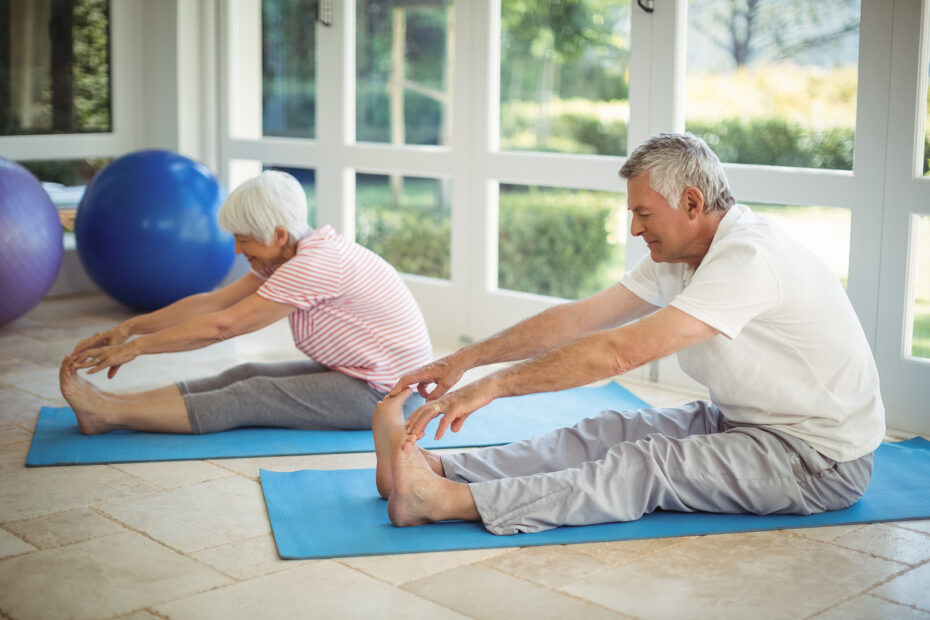Maintaining hamstring flexibility as you age is important for a few reasons.
For starters, having tight hamstrings not only affects your legs, but your overall mobility by decreasing the range of motion you have in your knees and hips.
Tight hamstrings can also lead to lower back pain, an issue adults of all ages deal with.
Improving hamstring flexibility can help contribute to better posture, easier movement, and a reduced risk of falls – all of which are significant concerns for most seniors.
In other words, improving hamstring flexibility comes with a lot of perks, but you should know up front that it takes time for these improvements to happen – this isn’t a quick fix.
But the good news is that there are lots of ways to stretch your hamstrings, many of which are safe for seniors.
Before starting any new physical activity, it’s always a good idea to consult with your healthcare provider. Never try any exercises you aren’t comfortable with and when in doubt, ask your doctor.
Safe and Effective Hamstring Stretches for Seniors
1. Lying Hamstring Stretch
This is a nice choice for seniors because you can do it from the comfort of your bed with your back and neck well supported.
FYI, this is considered an active stretch because you’re using your own muscle power to lift your leg up and stretch the hamstrings.
- From a lying position, bend one knee up toward your chest so that your hip is at about a 90° angle
- Place both hands behind your knee
- Gently extend your knee so that your foot is going up toward the ceiling
- Hold for 20-30 seconds and then switch to other leg
- Repeat 3-4x for each leg
2. Seated Hamstring Stretch
This is another great option for seniors, especially if you find it a little difficult to actively hold your leg up as mentioned in the stretch above.
FYI, this is more of a passive stretch because you can don’t have to actively hold your leg in position.
- While seated in a comfortable chair, scoot toward the edge and extend one leg out in front
- While keeping your knee straight, gently lean forward until you feel a stretch in the back of your thigh
- Try to maintain good upright posture throughout
- Hold for 20-30 seconds and then switch to the other leg
- Repeat 3-4x for each leg
3. Seated Hamstring Stretch with Ottoman/chair
This stretch is really similar to the one mentioned above, but instead of keeping your foot down on the floor, you can place it on a chair or ottoman in front of you.
This variation doesn’t require you to lean forward as far, making it a nice option for seniors with more severe back pain.
And depending on your level of tightness, you may feel a stretch with simply placing your leg up (and may not have to lean forward very far).
- From a seated position, place one leg up on an ottoman or chair
- While keeping your knee straight, gently lean forward until you feel a stretch in the back of your leg
- Hold for 20-30 seconds and switch to the other leg
- Repeat 3-4x for each leg
4. Seated Hamstring Stretch (Side of Bed)
Here’s another variation of a seated hamstring stretch.
This one could be a good choice for seniors who don’t have a comfortable chair to use or who don’t have access to an ottoman.
For this variation, you can simply use your own bed.
FYI, this stretch isn’t a good idea for seniors with really high beds or who don’t have the balance necessary to sit unsupported.
- While sitting on the edge of your bed, turn and extend one leg along the edge, while keeping the other leg down on the floor
- Keep your leg straight and gently lean toward your foot until you feel a gentle stretch behind your knee
- Hold for 20-30 seconds and then switch to the other leg
- Repeat 3-4x for each leg
5. Standing Hamstring Stretch (Heel Propped)
This standing stretch is a progression of the seated hamstring stretch with a chair, allowing for more range of motion.
For this stretch, you have to be comfortable standing with one leg elevated on a chair or step, so it’s likely not the best option for seniors with significant balance issues.
FYI, you can hold onto a kitchen counter or stair rail for support, so don’t feel like you have to balance yourself during this stretch.
Stairs work great for this exercise because you can choose from varying heights and hold onto the rail for additional safety.
- From a standing position, prop one foot up on a chair or step
- While keeping your knee straight, gently lean forward until you feel a stretch in the back of your thigh
- Hold for 20-30 seconds and then switch to the other leg
- Repeat 3-4x for each leg
Incorporating Hamstring Stretches into Daily Life
Creating a regular stretching routine can seamlessly fit into your daily life, making it easier to stay consistent.
It’s not about finding hours each day, but about integrating stretches into existing habits – you can stretch while watching TV, reading a book, or even while waiting for your coffee to brew.
Pairing stretches with other daily activities can also be effective.
For instance, do a quick hamstring stretch when you get out of bed in the morning or before you go to sleep at night. This helps make stretching a natural part of your day and ensures you don’t forget.
Staying motivated can be challenging, but setting small, achievable goals can keep you on track.
Perhaps aim to stretch three times a week and gradually increase as it becomes more natural. Keeping a diary or using an app to track your progress can also be a great motivator.

Monitoring Progress and Adapting Your Stretching Routine
Keeping track of your progress is essential to stay motivated and ensure you’re on the right track.
Pay attention to how you feel during and after your stretches – better balance, reduced pain, and increased ease in movement are clear signs that your flexibility is improving.
You can also see how far you can reach during your stretches today and compare it with a few weeks ago. You’ll be surprised at what consistent effort can achieve.
Adjusting your routine based on individual progress is important too.
If you notice certain stretches becoming easier, it might be time to gently increase the stretch duration or try a more advanced variation.
Listen to your body and avoid pushing too hard – low and steady improvement is more sustainable and safe.
Challenges can arise, such as muscle soreness or times when progress seems stagnant, but don’t get discouraged.
Everyone hits plateaus, but sticking to your routine will eventually yield results.
If soreness occurs, give your muscles time to recover by taking a day or two off.
If your pain lasts longer than a couple of days, it could be a sign that your form is a little off or the exercise is too taxing.
In any case, you shouldn’t be experiencing pain while performing any of these exercises!
A mild discomfort in the hamstrings is normal during the stretching process, but you shouldn’t feel any sharp or lingering pains anywhere while stretching.
If you experience persistent discomfort or if something doesn’t feel right, please consult a healthcare professional.
They can help adjust your routine or suggest alternative stretches that might be more suitable for you.
Final Thoughts
When your hamstrings are flexible, you’re less likely to experience the muscle stiffness that often plagues seniors, aiding in maintaining a higher quality of life.
Having tight hamstrings can also lead to a lot of orthopedic issues, like back pain, knee pain, and pain pretty much anywhere else in your legs.
And if your hamstrings are really tight, then can even affect the way you’re walking or make it tough to get in and out of chairs.
In other words, we should all be stretching our hamstrings regularly.
But again, progression is the key – don’t try to push too hard too soon.
Start with these basic stretches and gradually increase the duration or intensity as your flexibility improves.
The goal is consistency and gradual improvement, not quick fixes.
That said, if you have any questions or comments, please leave ’em below and I’ll get back to you shortly.



